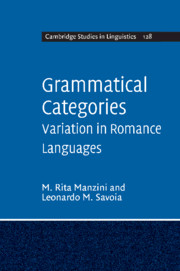Book contents
- Frontmatter
- Contents
- List of tables
- Acknowledgements
- Introduction: grammatical categories and the biolinguistic perspective
- 1 The structure and interpretation of (Romance) complementizers
- 2 Variation in Romance k-complementizer systems
- 3 Sentential negation: adverbs
- 4 Sentential negation: clitics
- 5 The middle-passive voice: evidence from Albanian
- 6 The auxiliary: have/be alternations in the perfect
- 7 The noun (phrase): agreement, case and definiteness in an Albanian variety
- 8 (Definite) denotation and case in Romance: history and variation
- Notes
- References
- Index
8 - (Definite) denotation and case in Romance: history and variation
Published online by Cambridge University Press: 11 April 2011
- Frontmatter
- Contents
- List of tables
- Acknowledgements
- Introduction: grammatical categories and the biolinguistic perspective
- 1 The structure and interpretation of (Romance) complementizers
- 2 Variation in Romance k-complementizer systems
- 3 Sentential negation: adverbs
- 4 Sentential negation: clitics
- 5 The middle-passive voice: evidence from Albanian
- 6 The auxiliary: have/be alternations in the perfect
- 7 The noun (phrase): agreement, case and definiteness in an Albanian variety
- 8 (Definite) denotation and case in Romance: history and variation
- Notes
- References
- Index
Summary
In historical accounts of the transition from Latin to the Romance languages, the loss of case morphology is related to the evolution of Latin demonstratives into articles and to the typological change from SOV word order to SVO word order.
Starting from the observation that change from Latin to Romance languages involved a shift from head-final order to head-initial order, Renzi (1987) proposes that in a string of the type N–k, the case suffix k, identified with a functional head, can no longer stay to the right of N, but must be reordered and move into first position. In terms of this explanation, the article is the lexical support for the case affix; the resulting sequence Art+k N realizes the desired head-initial order. In other words, the development of the Latin demonstrative into an article (cf. Vincent 1997) makes it possible for case to be lost as a nominal suffix.
This account is not without problems. For instance, it predicts that we should find some Romance language (or language stage) in which case is realized exclusively on the determiner – but in Old French both determiners and nouns have case (though the determiners may be argued to have a fuller set of case distinctions); and in Italian neither does. A potentially better argument for determiners bearing case to the exclusion of nouns is Romanian; in Romanian, however, the article is postnominal, and can be argued to be an inflection (section 8.2).
- Type
- Chapter
- Information
- Grammatical CategoriesVariation in Romance Languages, pp. 276 - 311Publisher: Cambridge University PressPrint publication year: 2011



